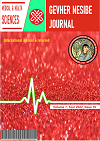Molecular Epidemiology: Definition And Usage Areas
DOI:
https://doi.org/10.46648/gnj.304Keywords:
Epidemiology, Molecular Epidemiology, Molecular Techniques, Biomarkers, Infectious DiseasesAbstract
In parallel with the technological developments in the last 20 years, the emergence of new techniques and the reduction in costs, molecular methods have gained importance in health sciences. The science of epidemiology, which deals with the etiology, distribution and prevention of diseases seen in both individual and society, has also benefited from molecular methods, especially since the 90s. Thanks to this partnership, “Molecular Epidemiology” has emerged as a sub-branch, which applies epidemiological studies at the molecular and biochemical level. In addition to the traditional epidemiological objectives such as identifying genetic and environmental risk factors of diseases, detecting susceptible individuals, detecting infectious agents, their reservoirs and distribution, objectives such as developing molecular diagnostic methods, examining and preventing infectious diseases, and identifying possible genetic causes of chronic diseases are among the study areas of molecular epidemiology. Pulse Field Gel Electrophoresis (PFGE), Polymerase Chain Reaction (PCR) based methods, Multi-locus VNTR (Variable Number Tandem Repeat) Analysis (MLVA), Multi-locus Sequence Typing (MLST) and DNA sequencing-based techniques are frequently used in examining the etiology of infectious diseases. When investigating chronic diseases such as cancer, several biomarkers are also used. Especially in cases where traditional epidemiological approaches are not sufficient, molecular methods are often preferred and even used as the gold standard in the diagnosis and detection of some diseases.
Downloads
Published
How to Cite
Issue
Section
License

This work is licensed under a Creative Commons Attribution-NonCommercial 4.0 International License.


